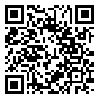1. Murrells T, Robinson S, Griffiths P. Job satisfaction trends during nurses' early career. BMC Nurs. 2008;7(1):7-13. [
DOI:10.1186/1472-6955-7-7] [
PMID] [
PMCID]
2. Joolaee S, Mehrdad N, Bohrani N. [A survey on nursing student's opinions toward nursing and reasons for giving it up]. I J N R. 2006;1(1):21-8.
3. Bolan C, Grainger P. Students in the BN program–Do their perceptions change? Nurse Educ Today. 2009;29(7):775-9. [
DOI:10.1016/j.nedt.2009.03.016] [
PMID]
4. Lu H, While AE, Barriball KL. Job satisfaction and its related factors: A questionnaire survey of hospital nurses in Mainland China. Int J Nurs Stud. 2007;44(4):574-88. [
DOI:10.1016/j.ijnurstu.2006.07.007] [
PMID]
5. Hossaini MA,Kakooyee H, Shah zeidi SH, Dibaei M.Determining the effect of training the continuous quality improvement on knowledge, attitude, performance and the level of occupational satisfaction of the nurses. IJNR .2006;1(1): 29-34.
6. Norozi Koshali A, Haji Amini Z, Ebadi A. [A comparison between the attitudes of nurses in Critical Care Units and other wards towards the nursing profession]. J Crit Care Nurs. 2012;4(3):63-70.
7. Katsuki F, Goto M, Someya T. A study of emotional attitude of psychiatric nurses: Reliability and validity of the Nurse Attitude Scale. Int J Ment Health Nurs. 2005;14(4):265-70. [
DOI:10.1111/j.1440-0979.2005.00391.x] [
PMID]
8. Taghavi Larijani T, Ramezani Badr F, Khatoni A. Monjamed Z. [Comparison of the sources of stress among the senior nursing and midwifery students of Tehran Medical Sciences Universities]. Hayat. 2007; 13 (2): 61-70.
9. Callaghan P, Shan CS, Yu LS, Ching LW, Kwan TL. Attitudes towards mental illness: testing the contact hypothesis among Chinese student nurses in Hong Kong. J Adv Nurs. 1997;26(1):33-40. [
DOI:10.1046/j.1365-2648.1997.1997026033.x] [
PMID]
10. Raij K. Clinical learning in a hospital environment as described by student nurses. research report University of Helsinki, Department of Education. 2000.
11. Sand-Jecklin KE. Student Evaluation of Clinical Education Environment (SECEE): instrument development and validation. [cited 2009 Jun 2]. Available from: http://wvuscholar.wvu.edu:8881//exlibris/dtl/d3_1/apache_media/5897.
12. Shih W-M, Chuang S-H. Factors influencing student nurses' career choices after preceptorship in a five-year junior nursing college in Taiwan. Nurse Educ Today. 2008;28(4):494-500. [
DOI:10.1016/j.nedt.2007.09.001] [
PMID]
13. Daehlen M. Job satisfaction and job values among beginning nurses: A questionnaire survey. Int J Nurs Stud. 2008;45(12):1789-99. [
DOI:10.1016/j.ijnurstu.2008.06.005] [
PMID]
14. Toth JC, Dobratz MA, Boni MS. Attitude toward nursing of students earning a second degree and traditional baccalaureate students: are they different? Nurs Outlook. 1998;46(6):273-8. [
DOI:10.1016/S0029-6554(98)90083-5]
15. Granum V. Nursing students' perceptions of nursing as a subject and a function. J Nurs Educ. 2004;43(7):297-304. [
PMID]
16. Banaderakhshan H, Mehrabi Y, Sh Y, Mortazavi F, Saedi N. [Comparing knowledge, attitude and practice of senior nursing students and graduates of Shahid Beheshti University of Medical Sciencess]. Pejouhesh. 2005;29(1):37-43.
17. Glossop C. Student nurse attrition from pre-registration courses: investigating methodological issues. Nurse Educ Today. 2001;21(3):170-80. [
DOI:10.1054/nedt.2000.0525] [
PMID]
18. Huch MH, Leonard RL, Gutsch KU. Nursing education: Developing specification equations for selection and retention. J Prof Nurs. 1992;8(3):170-5. [
DOI:10.1016/8755-7223(92)90027-V]
19. Ehrenfeld M. Rotenberg A, Sharon R, Bergman R. Reasons for student attrition on nursing courses:a study. Nurs stand.1997; 11(23): 34-8. [
DOI:10.7748/ns1997.02.11.23.34.c2443] [
PMID]
20. Baggs JG, Ryan SA. ICU nurse-physician collaboration & nursing satisfaction. Nursing economic$. 1989;8(6):386-92.
21. Lindop E. Individual stress among nurses in training: why some leave while others stay. Nurse Educ Today. 1991;11(2):110-20. [
DOI:10.1016/0260-6917(91)90146-2]
22. Poreddi V, Konduru R, Math SB. Assessing the attitudes and perceptions towards nursing profession among nursing students. Nurs J India. 2012;103(1):6-8. [
PMID]
23. Flinkman M., M. Laine M., Leino-Kilpi H., Hasselhorn HM, Salantera S. Explaining young registered Finnish nurses' intention to leave the profession: A questionnaire survey. Int J Nurs Stud. 2008; 45(5):727-39 [
DOI:10.1016/j.ijnurstu.2006.12.006] [
PMID]
24. Bang, K.S., Kang JH, Jun MH, Kim HS, Son HM, Yu SJ, et al, Professional values in Korean undergraduate nursing students. Nurse Educ Today.2010;31(1):72–5 [
DOI:10.1016/j.nedt.2010.03.019] [
PMID]
25. Hartigan-Rogers JA, Cobbett SL, Amirault MA, Muise-Davis ME. Nursing graduates' perceptions of their undergraduate clinical placement. Int J Nurs Educ Scholarsh. 2007;4(1).:21-32 [
DOI:10.2202/1548-923X.1276] [
PMID]
26. Hickey MT. Baccalaureate nursing graduates' perceptions of their clinical instructional experiences and preparation for practice. J Prof Nurs. 2010;26(1):35-41. [
DOI:10.1016/j.profnurs.2009.03.001] [
PMID]






